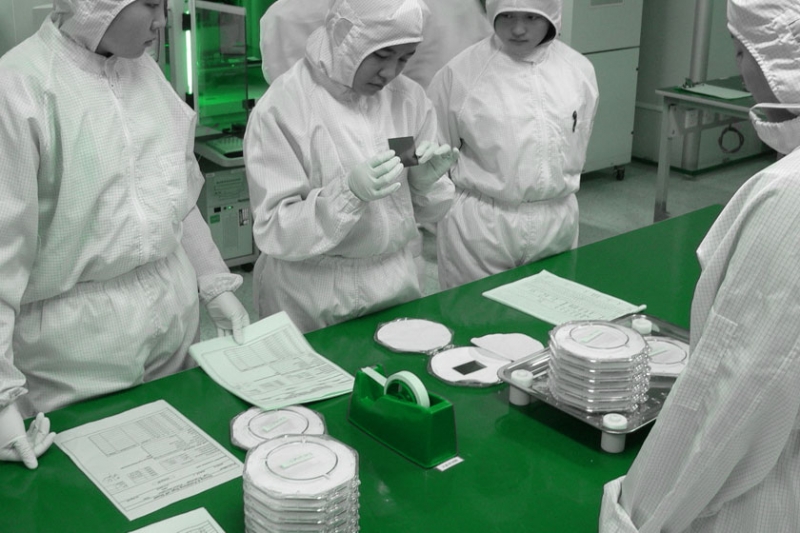The International Organization for Standardization (ISO, oddly) has qualified the definition of cleanrooms as:
A room in which the concentration of airborne particles is controlled, and which is constructed and used in a manner to minimize the introduction, generation, and retention of particles inside the room and in which other relevant parameters, e.g. temperature, humidity, and pressure, are controlled as necessary.
These rooms employ numerous types of specialized apparatuses, such as high efficiency particulate air (HEPA) ventilation systems, multiple airlocks, and pull-through windows, in order to keep the environment clean, but workers in the cleanroom introduce a different set of potential problems, largely due to basic human biology and the need for safety and efficiency. To address these issues, the controlled environments apparel industry designs a staggering assortment of cleanroom suits that prevent people and their clothing from introducing hair, skin and bacterial particles into these sterile, controlled environments. However, as technology and its manufacture require greater precision and more sterile conditions, manufacturers need to protect both production items and workers in a cost-effective manner. Fortunately, cleanroom apparel makers offer a number of options for most manufacturing requirements.
Importance & Purposes of Cleanrooms
To meet market demand, computer and microprocessor manufacturers are producing smaller and smaller components at an ever-increasing pace. As these parts grow smaller, they grow more sensitive to contaminants and, for many parts, even the slightest amount of dust or hair can cause significant problems (or total component failure). Medical equipment also requires a high degree of sterilization, for obvious reasons.
The ISO standardized cleanroom classifications with ISO 14644-1 in 2001, delimiting acceptable stratification of different classes of cleanrooms. When the United States adopted this method, they abandoned the previously used US FED STD 209E in favor of the new international standard, although these classifications are still sometimes employed. Basically, these systems quantify the maximum number of particles which can be present per cubic space of air (English system for the US, metric for ISO). ISO 1, the highest grade cleanroom, allows no more than 0.2 µm particles per m3. Compare that with non-filtered room air, ISO 9, which can have as much as 35.2 million 0.5 µm particles per m3.
Elements of Cleanroom Suits
Cleanroom suits, like cleanrooms themselves, come in a variety of designs, but there is no standardization of suits as there is for the facilities themselves. Depending on the facility, though, and its ISO classification, different levels of personal protective equipment (PPE) are required. A standard “bunny suit” consists of
- coverall jumpsuit or frockWorkers getting dressed in cleanrooom suits
- hood
- mask
- goggles
- booties
- gloves
Most of these items are made from nigh-impermeable synthetic materials and rubber in order to hermetically seal in human particles and keep out possibly dangerous materials. In “cleaner” cleanrooms, employers will often supply workers with a personal ventilation unit, so their breath will have less a chance of contaminating the environment. These ventilation units are also present if there is a chance of exposure to harmful materials, such as radiation and harmful chemicals, and the seams of the suit will be sealed with duct tape or another heavy-duty sealant.
A cleanroom worker will remove nonessential items and store them in a locker, then put on the bunny suit in a changing room, which, while not ISO 2 clean, is also controlled. Putting on all the elements of the complete suit can require a lot of time, from a mere five minutes to almost an hour, depending on the number of articles and the experience of the technician.
Cleanroom Suits in the 21st Century
The controlled environments apparel industry is focusing on advancements in areas deemed important by manufacturers and cleanroom workers—prevention of particle transmission, both to and from human workers; and the comfort and safety of cleanroom workers exclusive of particle transmission. For instance, in cleanrooms where workers are required to perform more delicate work, gloves are hand specific, not ambidextrous. Additionally, if workers are exposed to latex over longer periods of time, they may develop a latex allergy, so numerous safety apparel manufacturers produce cleanroom suit components (e.g., gloves) from other materials.
In an effort to speed up the sometimes lengthy process of donning the cleanroom suit, companies have developed a number of new technologies. For instance, one type of step pad can seal a worker’s street shoe in recyclable plastic in approximately seven seconds, thereby helping workers avoid tracking contaminants into the cleanroom environment. Another type of step pad mechanically brushes and cleans shoes. Alternatively, cleanroom apparel manufacturers produce a wide selection of special cleanroom shoes. These shoes are made from contaminant-resistant material and are ergonomically designed to prevent fatigue and discomfort for workers expected to stand for long periods of time.
Suits in Action
Cleanrooms regularly appear in science and medical programming, and are frequently (although not always accurately) reproduced in movies and television series. A recent string of Intel commercials also featured cleanroom workers in the midst of making microprocessors. Typically, this type of manufacturing facility is known as a “fab,” and fab workers wear the full head cover hoods and face masks shown in the commercials.
These types of suits are effective means of sustaining the delicate conditions essential to the production of sensitive computer parts, and are also employed in research facilities. A variety of different industries, including aerospace, medical device, and nanotechnology, require this level of protection, due to the sensitivity of the products being manufactured. In research specifically, the X-factor of contaminants can alter results, producing incorrect data, the consequences of which are fairly easy to imagine.











